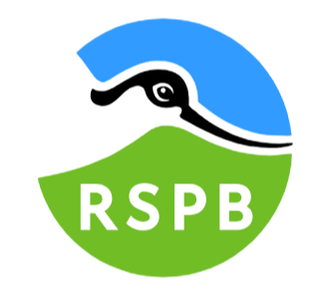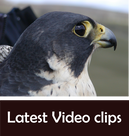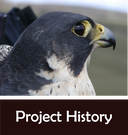|
Introduction
The Glasgow Peregrine Project brings together a series of conservation bodies in an exciting and imaginative initiative to bring one of the planet’s most dynamic species to the people of Glasgow and through the SOC Clyde Branch website, the world. The project is led by The Scottish Ornithologists’ Club, University of Glasgow and the RSPB. Other organisations support the conservation effort, The Glasgow Natural History Society, Scottish Wildlife Trust, Glasgow City Council, Friends of Glasgow’s LNR’s and the Scottish Raptor Study Group. The fascinating life of the Peregrine pair are brought to the public through engagement events at a dedicated watchpoint and all social media platforms. |
Timeline 2024: Ringing of the 4 chicks: Friday 24th May Chick four hatched: Wednesday 1st May Chick three hatched: Saturday 27th April Chick two hatched: Saturday 27th April Chick one hatched: Saturday 27th April Fourth egg laid: Monday 25th March Third egg laid: Saturday 23rd March Second egg laid: Thursday 21st March First egg laid: Monday 18th March |

Latest videos from the Gilbert Scott Tower cameras, at University of Glasgow..
Videos below from the two installed cameras - dates / times are on the video files
Videos below from the two installed cameras - dates / times are on the video files
Feeding time + one more from ringing
|
At the Peregrine Watch (25th May) we saw the male arrive with prey and watched from the ground as the parents fed the chicks. This is the footage from the nest camera at the same time. The youngest chick, the one with the most white down is being well fed which is good to see. You can see that once the female (L7) arrives, the male backs away and leaves the nest.
|
video courtesy of Clarke Elsby, University of Glasgow
Another clip of the rope team preparing to descend to the nest (under licence). You can see the rucksack that the ringers used to bring the chicks up and down in.
|
Ringing of the 4 chicks
|
video courtesy of Clarke Elsby, University of Glasgow
Here are some clips from the tower on the day the chicks were ringed (Friday 24th May). We now know that 3 of the chicks are male and 1 is female.
|
video courtesy of Clarke Elsby, University of Glasgow
You can see that as well as adding a colour ring to one leg of each chick, a DNA sample is also taken.
|
video courtesy of Clarke Elsby, University of Glasgow
The DNA sample is used to give each chick an identity in a database which is used to prove the birds are from a wild source. This is the youngest chick - note the blue feet compared to its siblings. This will change as it gets older.
|
4 hungry chicks keeping the parents busy!
|
Good people of Glasgow, you are now the proud owners of four little Peregrine chicks! The fantastic story of this remarkable pair saw the last egg hatch safely. Both parents are sharing the brooding duties whilst getting out to hunt for their voracious chicks!
|
The male is hunting all over the city centre and provisioning the family with 5 prey items a day (usually feral pigeons). This clip shows the female grabbing the pigeon carcass in a mid-air food pass!
|
This clips shows the female bringing in a pigeon carcass with the excited screaming calls of the chicks in the background
|
Eggs hatching!
|
Clip of chick no.1 from Saturday 27th April
|
Later the same day - this clip shows the male moving off the nest as the female arrives back - but revealing now that two eggs have hatched!
|
Interesting Peregrine behaviour
|
Morning... I've brought you breakfast!
The raptor research part of the project is showing that the male is flying into the city centre to hunt the feral pigeon concentration in George Square. He often catches one and takes it up onto the City Chambers where he plucks it, eats some and brings the rest back for the female in the form of a food pass at the nest. |
What a stunning and formidable bird! This is classic food begging behaviour from our female L7. This display is a clear message to the male to bring her something to eat or come in to protect the clutch while she goes for a short relief flight.
|
A lovely clip showing a nest changeover which allows the female to stretch her wings and hunt for prey within a short radius of the nest site.
|
|
It's important for Peregrines to keep their plumage in top condition. Our male spends a lot of his time preening when he's not hunting or taking his share of incubation duties.
|
Whilst the female is conducting the majority of incubation duties, the male's responsibility is to catch prey and be on guard to protect the nest. This wonderful clip shows the relationship well and when the eggs hatch and more prey is required, you'll be able to see this behaviour live during one of the many organised watches with the Glasgow Peregrine Project team!
|
Wait for it! First thing in the morning, the female is taking time for a wing stretch, a chance to relieve herself and have a squirt while the male stands guard over the nest. It looks as if she sees a target of opportunity, and takes a stoop. We think she might have seen a bat or tried to catch her breakfast - one of the roosting pigeons on the Gilbert Scott Tower!
|
Egg laying clips
|
First Egg being laid - Monday 18th March
|
Second egg being laid - Thursday 21st March
|
Compilation of clips including third egg! Saturday 23rd March
|
|
Clips including the 4th egg - Monday 25th March
|
Other clips
|
Both birds with first two eggs
|
First two eggs in the nest
|
Female leaving the nest site
|
|
|
|
|
|
|
|
|
Video from 7th February when the cameras were installed
video courtesy of Clarke Elsby, University of Glasgow








